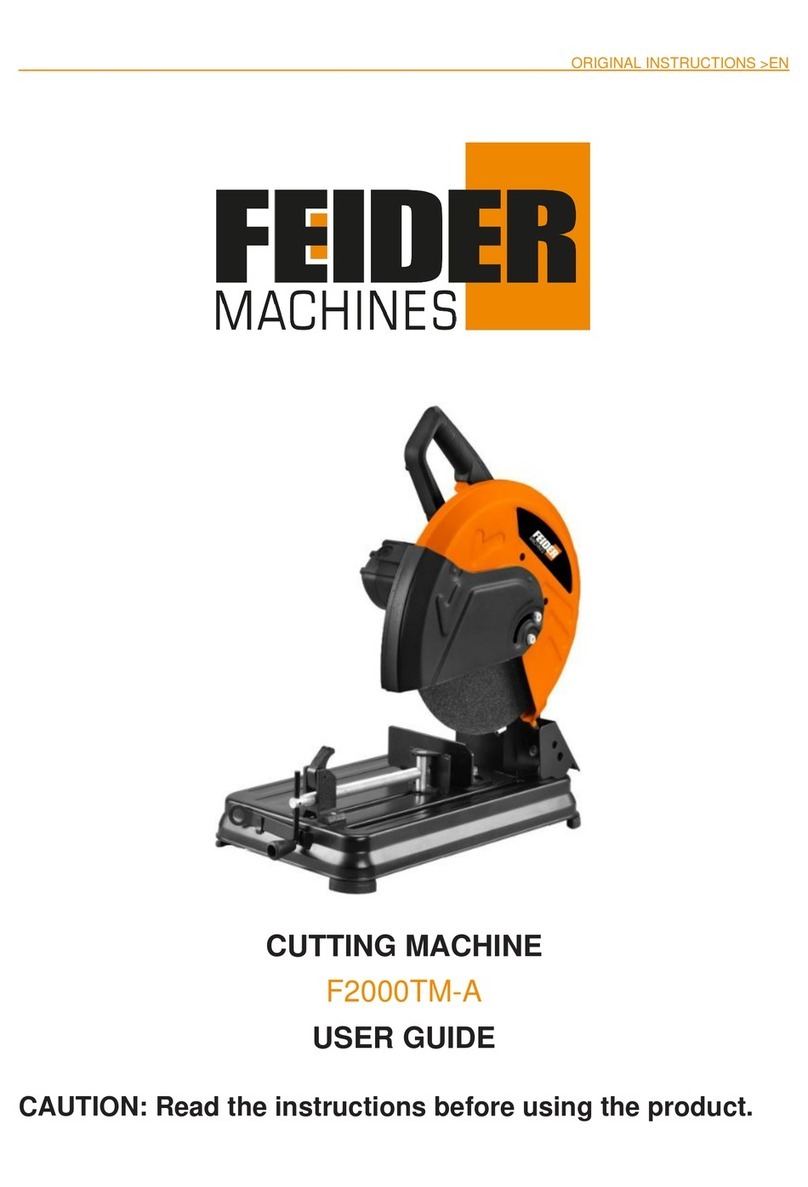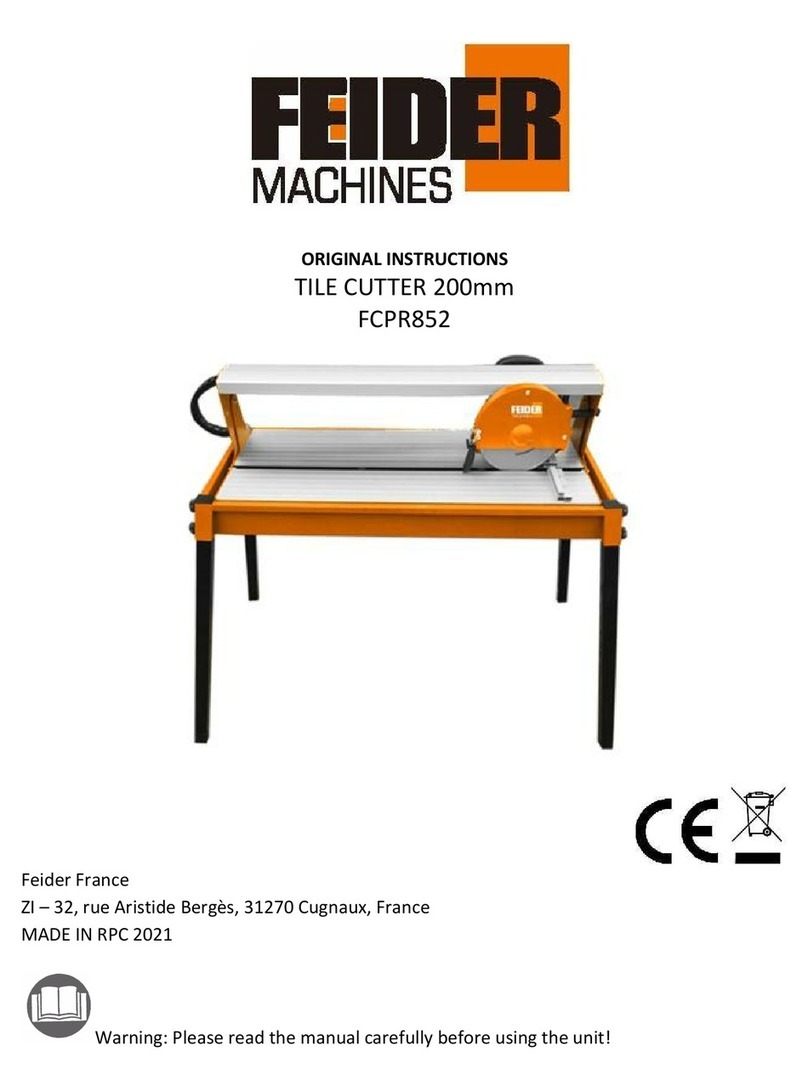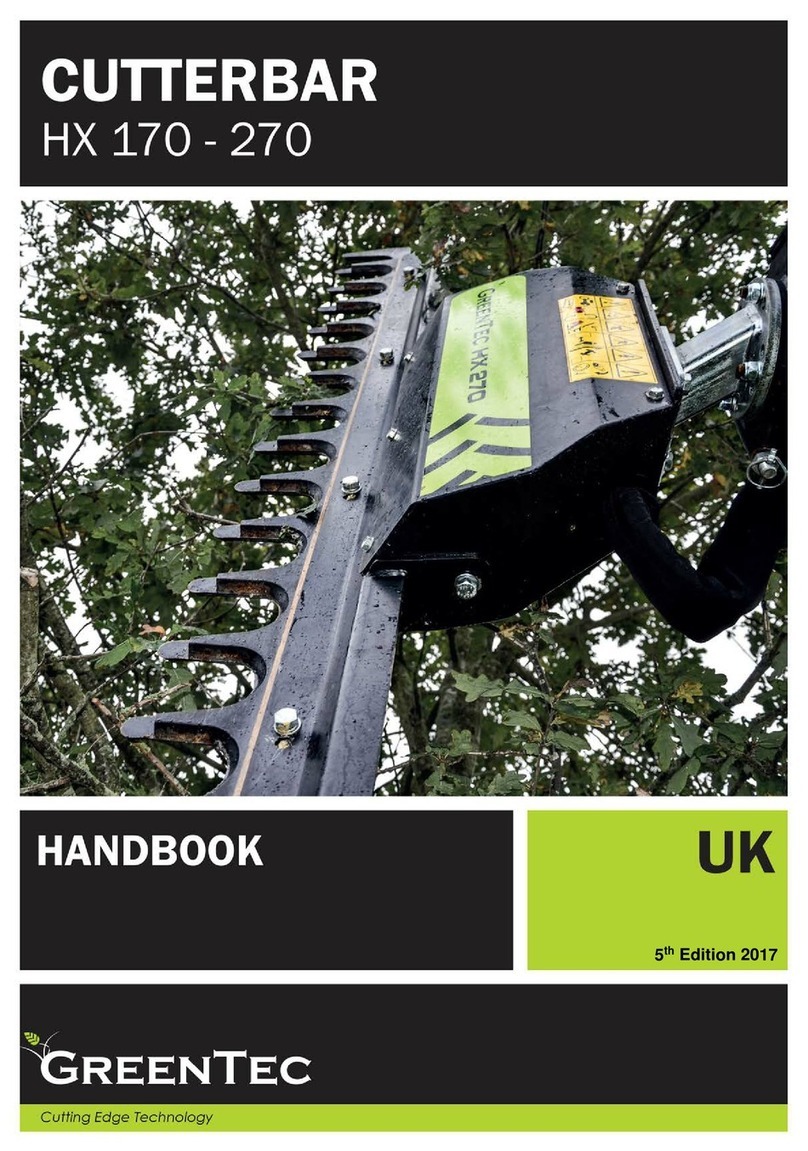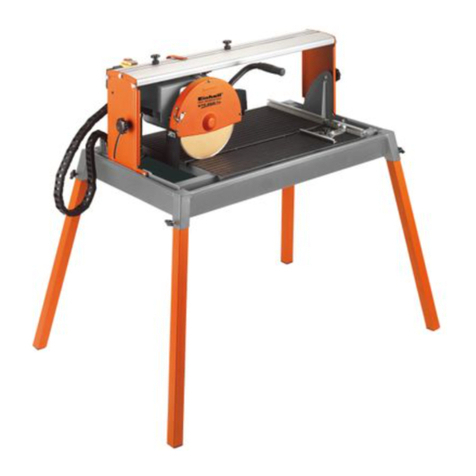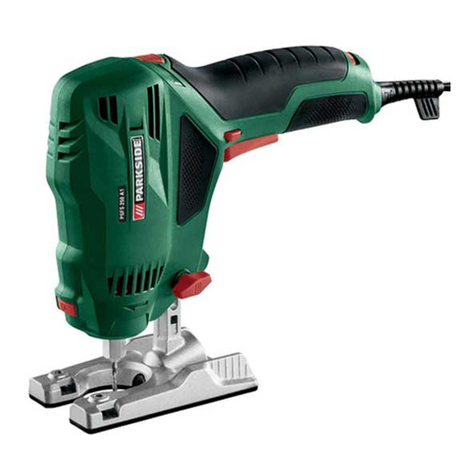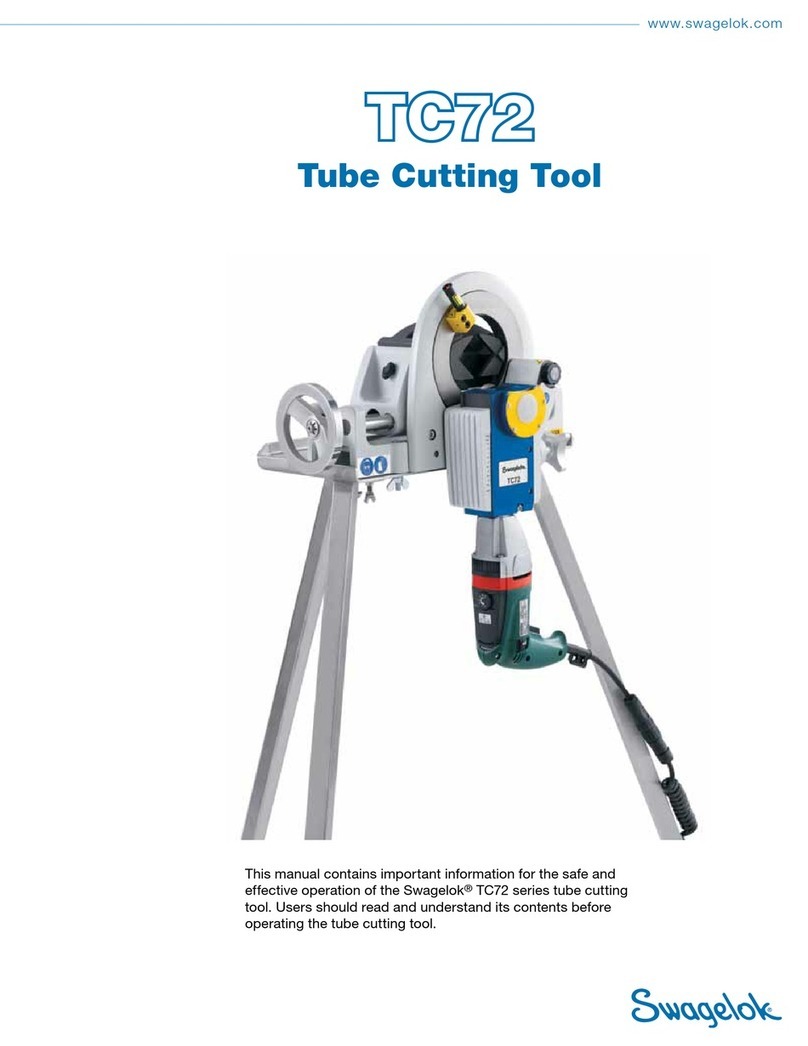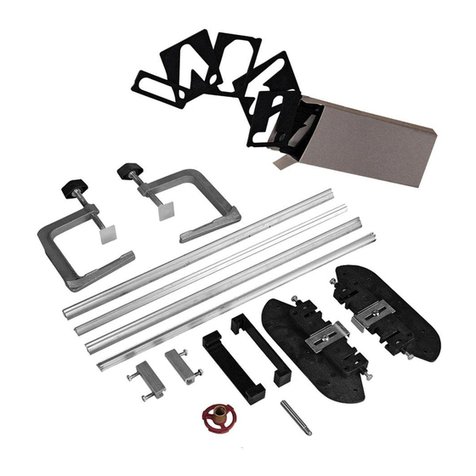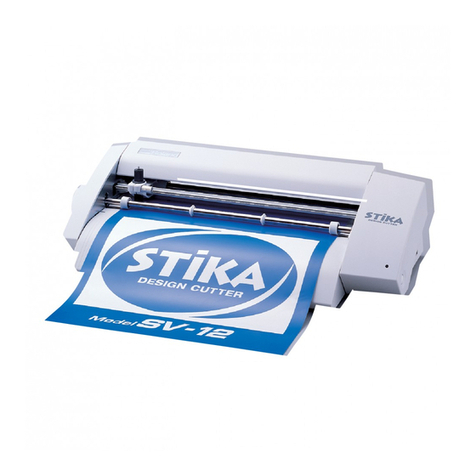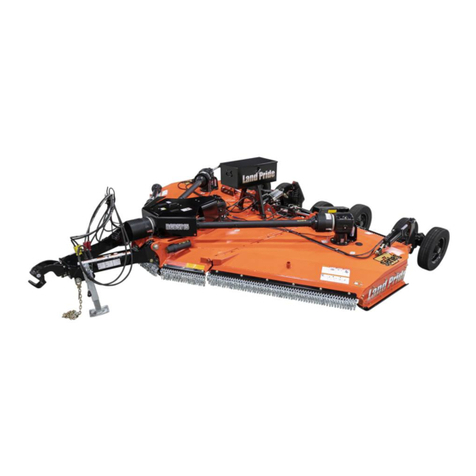Feider Machines FCPR852-A User manual

ORIGINAL INSTRUCTIONS >EN
ELECTRIC TILE CUTTER
FCPR852-A
USER GUIDE
CAUTION: Read the instructions before using the product.

2
CONTENTS
SAFETY INSTRUCTIONS ........................................................................................................................... 3
PRODUCT DESCRIPTION.......................................................................................................................... 7
SPECIFICATION ..................................................................................................................................... 11
ASSEMBLY AND PREPARATION……………………………………………………………………………………………………………..12
OPERATION ........................................................................................................................................ 14
MAINTENANCE ..................................................................................................................................... 14
TRANSPORTATION………………………………………………………………………………………………………………………………..14
STORAGE………………………………………………………………………………………………………………………………………………15
TROUBLESHOOTING………………………………………………………………………………………………………………………………15
DISPOSAL ............................................................................................................................................. 15
DECLARATION OF CONFORMITY ........................................................................................................... 16
WARRANTY .......................................................................................................................................... 17
PRODUCT FAILURE................................................................................................................................ 18
WARRANTY EXCLUSIONS ...................................................................................................................... 19

3
SAFETY INSTRUCTIONS
Important!
Before each use (!) and regularly during work the user must:
- perform visual inspection of the tool,
- inspect the general condition of the tool,
- check the tool, the accessories and the safety equipment for integrity,
- check the security of fastening elements, units, attachments etc., bolts tightening etc.,
- check for other damages (incl. leaks) and other deviations from the norm.
If found, those defects must be eliminated before starting using the tool.
It is prohibited and dangerous (!) to use the tool which has damages or loosened fastening elements
because of potential for injury (!).
The manufacturer shall not be liable for the consequences and damages as a results of use of the tool with
the above-named defects.
GENERAL POWER TOOL SAFETY WARNINGS
WARNING Read all safety warnings, instructions, illustrations and specifications provided with this
power tool. Failure to follow all instructions listed below may result in electric shock, fire and/or serious
injury.
Save all warnings and instructions for future reference.
The term "power tool" in the warnings refers to your mains-operated (corded) power tool or
battery-operated (cordless) power tool.
1) Work area safety
a) Keep work area clean and well lit. Cluttered or dark areas invite accidents.
b) Do not operate power tools in explosive atmospheres, such as in the presence of flammable liquids,
gases or dust. Power tools create sparks which may ignite the dust or fumes.
c) Keep children and bystanders away while operating a power tool. Distractions can cause you to lose
control.
2) Electrical safety
a) Power tool plugs must match the outlet. Never modify the plug in any way. Do not use any adapter
plugs with earthed (grounded) power tools. Unmodified plugs and matching outlets will reduce risk of
electric shock.
b) Avoid body contact with earthed or grounded surfaces, such as pipes, radiators, ranges and
refrigerators. There is an increased risk of electric shock if your body is earthed or grounded.
c) Do not expose power tools to rain or wet conditions. Water entering a power tool will increase the risk
of electric shock.
d) Do not abuse the cord. Never use the cord for carrying, pulling or unplugging the power tool. Keep
cord away from heat, oil, sharp edges or moving parts. Damaged or entangled cords increase the risk of
electric shock.
e) When operating a power tool outdoors, use an extension cord suitable for outdoor use. Use of a cord
suitable for outdoor use reduces the risk of electric shock.
f) If operating a power tool in a damp location is unavoidable, use a residual current device (RCD)
protected supply. Use of an RCD reduces the risk of electric shock.
3) Personal safety
a) Stay alert, watch what you are doing and use common sense when operating a power tool. Do not use
a power tool while you are tired or under the influence of drugs, alcohol or medication. A moment of
inattention while operating power tools may result in serious personal injury.
b) Use personal protective equipment. Always wear eye protection. Protective equipment such as a dust
mask, non-skid safety shoes, hard hat or hearing protection used for appropriate conditions will reduce
personal injuries.

4
c) Prevent unintentional starting. Ensure the switch is in the off-position before connecting to power
source and/or battery pack, picking up or carrying the tool. Carrying power tools with your finger on the
switch or energising power tools that have the switch on invites accidents.
d) Remove any adjusting key or wrench before turning the power tool on. A wrench or a key left attached
to a rotating part of the power tool may result in personal injury.
e) Do not overreach. Keep proper footing and balance at all times. This enables better control of the
power tool in unexpected situations.
f) Dress properly. Do not wear loose clothing or jewellery. Keep your hair and clothing away from
moving parts. Loose clothes, jewellery or long hair can be caught in moving parts.
g) If devices are provided for the connection of dust extraction and collection facilities, ensure these are
connected and properly used. Use of dust collection can reduce dust-related hazards.
h) Do not let familiarity gained from frequent use of tools allow you to become complacent and ignore
tool safety principles. A careless action can cause severe injury within a fraction of a second.
4) Power tool use and care
a) Do not force the power tool. Use the correct power tool for your application. The correct power tool
will do the job better and safer at the rate for which it was designed.
b) Do not use the power tool if the switch does not turn it on and off. Any power tool that cannot be
controlled with the switch is dangerous and must be repaired.
c) Disconnect the plug from the power source and/or remove the battery pack, if detachable, from the
power tool before making any adjustments, changing accessories, or storing power tools. Such
preventive safety measures reduce the risk of starting the power tool accidentally.
d) Store idle power tools out of the reach of children and do not allow persons unfamiliar with the
power tool or these instructions to operate the power tool.
Power tools are dangerous in the hands of untrained users.
e) Maintain power tools and accessories. Check for misalignment or binding of moving parts, breakage of
parts and any other condition that may affect the power tool’s operation. If damaged, have the power
tool repaired before use. Many accidents are caused by poorly maintained power tools.
f) Keep cutting tools sharp and clean. Properly maintained cutting tools with sharp cutting edges are less
likely to bind and are easier to control.
g) Use the power tool, accessories and tool bits etc. in accordance with these instructions, taking into
account the working conditions and the work to be performed. Use of the power tool for operations
different from those intended could result in a hazardous situation.
h) Keep handles and grasping surfaces dry, clean and free from oil and grease. Slippery handles and
grasping surfaces do not allow for safe handling and control of the tool in unexpected situations.
5) Service
a) Have your power tool serviced by a qualified repair person using only identical replacement parts. This
will ensure that the safety of the power tool is maintained.
ADDITIONAL SAFETY RULES FOR TILE CUTTER
1) Before maintenance, lubrication, adjustment and change of attachments, such as cutting blades, tips
and knives, make sure that electrically driven tools are turned off.
2) Do not stop the cutting blade by forcing the machine or using side pressure.
3) Do not use bent cutting blades or cutting blades with damages of any type. The use of bent or
damaged cutting blades is extremely dangerous and can lead to serious personal injury of the cutter, of
the persons standing nearby, and it can result in the machine breakdown.
4) Do not use cutting blades with a larger size than indicated. Use only cutting blades which are designed
for this machine. The speed of rotation (min-1) indicated on the cutting blade must be HIGHER than the
speed of rotation (min-1) of the tile cutter.
5) Make sure that the rotation arrow on the cutting blade corresponds to the rotation of the electric
motor.

5
6) Disconnect the machine from the power source and make sure that there are no hindrances by
manually turning the cutting blade.
7) Make sure that the removable guard works properly (no hindrances).
8) The guard must be installed and it must be in good working order. While the machine is disconnected
from the power source, check the operation of the guard and make sure it works properly.
9) When changing the cutting blades make sure that the surface of cutting blades and flanges is clean.
Make sure that the securing nut is fastened securely. Make sure that the nut is not overtightened.
10) Do not start the machine if the cutting blade contacts the processed part.
11) Do not cut when holding the tile with your hand, make sure that the tile is securely fastened in the
guide bar.
12) Make sure that there is enough space for taking the smaller piece of the tile being cut to the side.
Failure to meet this condition can result in the cut fragment being jammed by the cutting blade.
13) Do not cut more than one tile at a time.
14) Do not cut fragments which are too small and which do not enable fastening them securely on the
guide bar and keeping hands at a safe distance from the cutting blade.
15) Make sure that there are no foreign objects on the machine bench.
16) In case of binding of any objects in the machine disconnect it from the power source to remove the
jammed objects.
17) Do not remove the jammed object while the machine is still working.
18) Do not allow the machine to work without water. The absence of water in the tank results in cutting
blade overheating which leads to the breakdown thereof and incorrect tile cutting.
19) Do not try to modify the machine or its auxiliaries.
20) Do not overload the machine –it must perform its job; absence of overload reduces the wear of the
machine and of the cutting blade, it increases its work efficiency and service life.
21) When working on the machine use ear and eye protection.
22) Work on the tile cutter in waterproof protective clothing.
23) Decorative surfaces should be cut with the tile cutter using the dust shield and a plastic waterproof
shield.
24) Any modification which could lead to a change in the original characteristics of the machine, for
example, rotational speed or maximum diameter of the cutting-off wheel may be carried out only by
the manufacturer of the machine who shall confirm that the machine is still in conformity with the
safety regulations.
25) Place the tool in a flat and stable surface, free of obstacles (except materials to be cut) and adequately
lit;
26) Always check correct rotation of tool;
27) Always prevent any contact with the rotating tool;
28) Use no cutting-off wheels with a maximum operating wheel speed less than the rated spindle speed of
the machine;
29) Precautions must be taken for mounting, clamping and removing the cutting-off wheels, in particular:
i. Set the control device to the "off“ position;
ii. Separate the machine from its energy source by unplugging the main power supplies
30) The area shall be cleared of everything which may hamper the working action;
31) The correct mounting of the guards shall be verified.
32) for safety reasons each damaged (cracked) tool has to be replaced.
RESIDUAL RISKS:
Despite proper use, some residual risk factors cannot be completely excluded. Due to the construction and
structure of the machine, the following events may occur:
1) Intervention in the diamond blade in operation.
2) Contact of the diamond blade in the unprotected area.
3) Ejection of coins and pieces of coins.
4) Ejection of a defective diamond blade tip.
5) Hearing damage if adequate hearing protection is not used.

6
6) Eye damage if eye protection is not used.
7) Any use other than that described above is considered improper. The manufacturer is not liable for any
resulting damage; the user is solely responsible for this.
DESCRIPTION OF THE SYMBOLS
The use of symbols in this manual is intended to draw your attention to possible risks. The safety symbols
and the explanations that accompany them must be perfectly understood. The warnings in themselves do
not remove the risks and cannot replace correct actions for preventing accidents.
CAUTION!!! DANGER
RECOMMENDATION: USE HEARING PROTECTION
RECOMMENDATION: USE EYE PROTECTION
CAUTION –Risk of cutting
Confirms compliance with all safety standards
RECOMMENDATION READ THE MANUAL
RECOMMENDATION USE PROTECTIVE GLOVES
Do not dispose of old appliances with domestic rubbish .

7
PRODUCT DESCRIPTION
Fig. A
Fig. B

8
Fig.C
Fig.D

9
Fig.E
Fig.F
Fig.G

10
Fig.H
LIST OF MAIN PART (Fig.A)
1 On/off switch
2 Handle
3 Head lock knob
4 Cutting disc
5 Water tray
6 Leg
7 Scale for miter angle
8 Work table top
9 Supports
10 Pointer
11 Lock knob bevel angle
12 plug
13 Water pump
14 Pad
15 Cross head screw
16 Washer
17 Long fence
18 Short fence
19 Spring washer
20 Nut
21 Cross head screw
22 Washer
23 Pad
24 Washer
25 Water pipe
26 Cable for water pump
27 Inner flange
28 Cutting disc
29 Outer flange
30 Fixing bolt
31 Outer guard
32 Bolt
33 Protractor
34 Rubber cap
35 Lock knob
36 Pointer
37 Angle ruler fixer
38 Screw
39 Sliding block
40 Pump filter
41 Fixation Bolt

11
SPECIFICATION
Voltage/Frequency
No-load speed
Motor power
Cutting blade size
Spindle output diameter
Table size
Max. cutting depth at 90°
Max. cutting depth at 45°
230 V~50 Hz
2980/min
800 W (S2:15min)
Ø200 x 22.2mm
14mm
680 mm x 380mm
35 mm
28 mm
Max. cutting length
Inclined cutting
IP class
Net weight
Water pump capacity
Body Weight(Kg)
Water Tank Weight(Kg)
620 mm
0-45°
IP 44
32.8 kg
600 l/h
21.8kg
11kg
Only diamond blade can be used for this machine, blade size Ø 200 x Ø 22.2mm
Materials which can be cut-off by the machine: Tile and domolite
Remark
-The use of all other types of wheels or tool (such as for example circular saw blades) which are not
indicated in the list is not allowed.
-any modification which could lead to a change in the original characteristics of the machine, for
example, rotational speed or maximum diameter of the cutting-off wheel may be carried out only by
the manufacturer of the machine who shall confirm that the machine is still in conformity with the
safety regulations.
Noise and vibration level:
Sound pressure level LpA
97.4 (A)
Sound power level LWA
102.3 dB(A)
Uncertainty K
4 dB(A)
Vibration level hand/arm:
3.74 m/s2
Uncertainty K:
1.5m/s2
The declared total vibration value was measured using standard test method and can be used for
comparing tools. The declared total vibration value can also be used during initial exposure estimation.
WARNING: Depending on the actual way of using the tool, vibration values can be completely different
from the declared values. The need of identifying personal protective equipment and operator protection is
based on exposure estimation in actual working conditions (taking into consideration all parts of the work
cycle, such as product downtime, idle work, and running time).

12
ASSEMBLY AND PREPARATION
Follow the assembly instructions step-by-step and use the pictures provided as a visual guide to easily
assemble the product!
Do not connect the product to power supply before it is completely assembled!
NOTE: Take care of small parts that are removed during assembly or when making adjustments. Keep them
secure to avoid loss.
For the assembly two people are recommended.
ASSEMBLING THE COOLING WATER RESERVOIR (FIG. B)
Always use the following procedure, in the order given, when assembling the water tray.
Place the water tray (5) upside down on a flat, stable surface.
Mount the first pad (14) in the leg.
Mount the first table leg (6) in place.
Mount the other legs (6) according to the same instructions.
Turn the assembled water tray (5) with the legs (6) right way up and place it on a firm flat and even surface.
MOUNTING THE WORK TABLE (FIG.C)
Hold the long fence (17) in place and fit using cross head screw (15).
Do not completely tighten the cross head screw when start to fit another side screws.
Tighten the screws when both of them are fit.
Mount the short fence (18) according to the same instructions.
Mount the pad (23) in place and fit using the cross head screw (21).
REPLACING THE CUTTING DISC (FIG. D)
Before replacing the cutting disc always turn off and unplug the tool.
Only use sharp and undamaged cutting discs. Cracked or bent cutting discs must be replaced immediately.
- Loose the bolt (32).
- Unscrew the outer guard (31).
- Use wrench to remove the fixing bolt (30).
- Remove the outer flange (29), the old cutting disc (28) and the inner flange (27).
- Clean the flanges.
- Place the inner flange, the new cutting disc and the outer flange. When fitting the cutting disc, make sure
that the direction of rotation corresponds to the arrow on the guard.
- Fit the fixing bolt and use wrench to securely tighten it.
- Fit the outer guard using the bolts.
Make sure that the spindle diameter and the bore match. Do not use an adapter to mount a cutting disc
with a larger bore.
WARNING! Always use the correct cutting disc according to the intended use!
Observe the technical requirements of this product (see Technical data) when purchasing and using
cutting discs!
Cutting discs are sharp and become hot during use! Handle them carefully! Wear safety gloves when
handling cutting discs in order to avoid injuries like burns and cuts
ADJUSTING THE BEVEL ANGLE (FIG. E)
The bevel angle is infinitely variable between 0°and 45°.

13
- Loosen the bevel locking knobs on both sides (11).
- Set the required angle using the pointer (10).
- Tighten the locking knobs.
MOUNTING AND ADJUSTING THE MITRE FENCE (FIG. F)
The mitre angle is infinitely variable between 0°and 45°.
To install the mitre fence proceed as follow :
- Loosen the screw (38) a few turns.
- Insert the sliding block (39) into the long fence (17).
- Set the mitre angle or adjust the mitre fence for use as an end stop.
- Tighten the screw (38).
To set the mitre angle, proceed as follows:
- Loosen the lock knob (35).
- Set the desired angle using the finger on the protractor (33).
- Tighten the lock knob (35).
FITTING THE PUMP (FIG. G)
- Make sure that the water pipe (25) is fully connected to water pump (13).
- Lower the pump (13) carefully in the water.
- Check if the motor can be freely moved back and forth. The mains cable and hose should not be pulled
tight and the pump should not be pulled out of the water.
Never let the pump run dry. Always make sure that the suction opening is fully immersed.
MOVING THE CUTTING HEAD (FIG. H)
Remove the fixation bolt (41) to allow the cutting head to be moved.
During transport and storage the head should always be fixed thanks to bolt (41)
FILLING THE WATER TRAY :
Before filling the water tray always turn off and unplug the tool!
WARNING! Lack of cooling water may damage the saw disc .Never turn on the machine without enough
water in the tray or without plugging in the water pump!
a) Insert the water plug into the hole of the water tray.
b) Pour water into the tray. To ensure proper operation, make sure the pump is always full immersed in
the water( about 2/3 depth of water tray). Do not overfill. Check the water level constantly during use and
refill if necessary.
CAUTION! If the water flow from the pump is reduced or has stopped. Change for a new pump or have
the pump repaired by qualified personnel.
NOTE: To drain the water, remove the water plug from the hole in the water tray and allow it to drain, or
remove the water tray and pour the water out!

14
OPERATION
WARNING! The product must be fully assembled before operation! Do not use a product that is only
partly assembled or assembled with damaged parts!
Notes
1. Check the cutting disc before every use for damage and wear. Replace it with a new one if required.
2. Only use a cutting disc that is suitable for the intended application.
3. Do not use any abrasive wheels.
4. The operator should stands on the right side of the machine ( near the ruler side), facing the direction o
f the guide rail, then holds the handle with right hand,pulls the machine head to cut.
a. Remove the fixation bolt(41) before use.
b. Before switching the machine on, make sure that the water pump is immersed.
c. Switch on the machine before the cutting disc touches the workpiece.
d. Place the workpiece against the fence or mitre fence.
e. Keep the workpiece in place and slowly guide the cutting disc through the workpiece.
f. Do not exert pressure on the cutting disc. Allow the machine enough time to cut the workpiece.
g. Regularly check if the cutting disc is sufficiently cooled.
h. Make sure that the lower edge of the cutting disc is well below the water level in the cooling water tray.
Add some cooling water if necessary.
i. Lock the head after use.
Switching on and off
- To switch the machine on, set the on/off switch (1) to ‘I’.
- To switch the machine off, set the on/off switch (1) to ‘0’
MAINTENANCE
CLEANING
Empty the water reservoir and remove from the reservoir and the table any dust deposits remaining after
cutting. Clean the tile cutter using clean, dry cloth. From time to time, depending on the degree of dust
deposit accumulation, clean the water pump, making sure that filters are clean and not clogged.
REPAIR
This product does not contain any parts that could be repaired by the customer. For service and repairs
turn to a qualified professional at SWAP, https://swap-europe.com
Power supply
If the replacement of the supply cord is necessary, this has to be done by the manufacturer or his agent in
order to avoid a safety hazard.
TRANSPORTATION
a) Before transporting and moving the product to any other location, turn it off and unplug the power.
b) Install transport covers, if applicable.
c) Protect the product from strong impacts or strong vibrations that can occur during vehicle transport.
d) Protect the product from slipping and falling over.

15
STORAGE
a) Clean the product as described above.
b) Store the product and its accessories in a dry, frost-free place.
c) Always store the product in a place out of reach of children. The perfect storage temperature is
between 10 and 30°C.
d) We recommend using the original packaging for storing the product or covering it with an appropriate
cloth, to protect it from dust.
TROUBLESHOOTING
It is suspected, that faults are often caused by reasons that users can remove by themselves. That is why
the product should be checked using this section. In most cases the problem can be quickly resolved.
Problem
Possible cause
Solution
1. Product does not start
1.1. Power not connected
1.2. Damaged power cord
or plug
1.3. Other electrical fault of
the product
1.1. Connect the power
1.2. Check by a qualified electrician
1.3. Check by a qualified electrician
2. Product does not reach
full power
2.1. Extension cord not
suitable for the product
2.2. Power supply (eg.
generator) voltage too low
2.3. Vents are blocked
2.1. Use a suitable extension cord
2.2. Connect to another power supply
2.3. Clear the vents
3. Unsatisfactory work
results
3. Accessory not suitable
for the material
3. Use a suitable accessory
DISPOSAL
Electrical products should not be discarded with household products. According to the
European Directive 2012/19/EU on waste electrical and electronic equipment and its
implementation into national law, electrical products used must be collected separately and
disposed of at collection points provided for this purpose. Talk with your local authorities or
dealer for advice on recycling.

16
EC DECLARATION OF CONFORMITY
Declaration of conformity
FEIDER FRANCE
ZI, 32 RUE ARISTIDE BERGES –312070 CUGNAUX –FRANCE
Declares that the machinery designated below:
Tile Cutter
Model: FCPR852-A
Serial number: 20220301192-20220302391
Complies with the provisions of the Directive « Machinery » 2006/42/EC and national laws transposing it:
Also complies with the following European directives:
EMC Directive 2014/30/EU
ROHS Directive 2011/65/EU
Also complies with European standards, with national standards and the following technical provisions:
EN 62841-1:2015+AC:15
EN 12418:2000+A1:2009 (applicable parts)
EN55014-1:2017+A11:2020
EN55014-2:2015
EN61000-3-2:2019
EN61000-3-3:2013+A1:2019
Cugnaux, 24/02/2022
Philippe MARIE / PDG

17
WARRANTY
The manufacturer guarantees the product against defects in material and workmanship for a period of 2
years from the date of the original purchase. The warranty only applies if the product is for household use.
The warranty does not cover breakdowns due to normal wear and tear.
The manufacturer agrees to replace parts identified as defective by the designated distributor. The
manufacturer does not accept responsibility for the replacement of the machine, in whole or in part,
and/or ensuing damage.
The warranty does not cover breakdowns due to:
insufficient maintenance.
abnormal assembly, adjustment or operations of the product.
parts subject to normal wear and tear.
The warranty does not extend to:
shipping and packaging costs.
using the tool for a purpose other than that for which it was designed.
the use and maintenance of the machine done in a manner not described in the user manual.
Due to our policy of continuous product improvement, we reserve the right to alter or change
specifications without notice. Consequently, the product may be different from the information contained
therein, but a modification will be undertaken without notice if it is recognized as an improvement of the
preceding characteristic.
READ THE MANUAL CAREFULLY BEFORE USING THE MACHINE.
When ordering spare parts, please indicate the part number or code, you can find this in the spare parts list
in this manual. Keep the purchase receipt; without it, the warranty is invalid. To help you with your product,
we invite you to contact us by phone or via our website:
+33 (0)9.70.75.30.30
https://services.swap-europe.com/contact
You must create a "ticket" via the web platform.
Register or create your account.
Indicate the reference of the tool.
Choose the subject of your request.
Describe your problem.
Attach these files: invoice or sales
receipt, photo of the identification plate
(serial number), photo of the part you
need (for example: pins on the
transformer plug which are broken).

18
PRODUCT FAILURE
WHAT TO DO IF MY MACHINE BREAKS DOWN?
If you bought your product in a store:
•Empty the fuel tank if the product has one.
•Make sure that your machine is complete with all accessories supplied, and clean! If this is not the case,
the repairer will refuse the machine.
•Go to the store with the complete machine and with the receipt or invoice.
If you bought your product on a website:
•Empty the fuel tank if the product has one.
•Make sure that your machine is complete with all accessories supplied, and clean! If this is not the case,
the repairer will refuse the machine.
•Create a SWAP-Europe service ticket on the site: https://services.swap-europe.com When making the
request on SWAP-Europe, you must attach the invoice and the photo of the nameplate (serial number).
Contact the repair station to make sure it is available before dropping off the machine.
Go to the repair station with the complete machine packed, accompanied by the purchase invoice and the
station support sheet downloadable after the service request is completed on the SWAP-Europe site
For machines with engine failure from manufacturers BRIGGS & STRATTON, HONDA and RATO, please refer
to the following instructions.
Repairs will be done by approved engine manufacturers of these manufacturers, see their site:
•http://www.briggsandstratton.com/eu/fr
•http://www.honda-engines-eu.com/fr/service-network-page;jsessionid=5EE8456CF39CD572AA2AEEDF
D290CDAE
•https://www.rato-europe.com/it/service-network
Please keep your original packaging to allow for after-sales service returns or pack your machine with a
similar cardboard box of the same dimensions.
For any question concerning our after-sales service you can make a request on our website
https://services.swap-europe.com
Our hotline remains available at +33 (9) 70 75 30 30.

19
WARRANTY EXCLUSIONS
THE WARRANTY DOES NOT COVER:
•Start-up and setting up of the product.
•Damage resulting from normal wear and tear of the product.
•Damage resulting from improper use of the product.
•Damage resulting from assembly or start-up not in accordance with the user manual.
•Breakdowns related to carburetion beyond 90 days and fouling of carburetors.
•Periodic and standard maintenance events.
•Actions of modification and dismantling that directly void the warranty.
•Products whose original authentication marking (brand, serial number) has been degraded, altered or
withdrawn.
•Replacement of consumables.
•The use of non-original parts.
•Breakage of parts following impacts or projections.
•Accessories breakdowns.
•Defects and their consequences linked to any external cause.
•Loss of components and loss due to insufficient screwing.
•Cutting components and any damage related to the loosening of parts.
•Overload or overheating.
•Poor power supply quality: faulty voltage, voltage error, etc.
•Damages resulting from the deprivation of enjoyment of the product during the time necessary for
repairs and more generally the costs related to the immobilization of the product.
•The costs of a second opinion established by a third party following an estimate by a SWAP-Europe
repair station
•The use of a product which would show a defect or a breakage which was not the subject of an
immediate report and/or repair with the services of SWAP-Europe.
•Deterioration linked to transport and storage*.
•Launchers beyond 90 days.
•Oil, petrol, grease.
•Damages related to the use of non-compliant fuels or lubricants.
* In accordance with transport legislation, damage related to transport must be declared to carriers within
48 hours maximum after observation by registered letter with acknowledgement of receipt.
This document is a supplement to your notice, a non-exhaustive list.
Attention: all orders must be checked in the presence of the delivery person. In case of refusal by the
delivery person, it you must simply refuse the delivery and notify your refusal.
Reminder: the reserves do not exclude the notification by registered letter with acknowledgement within
72 hours.
Information:
Thermal devices must be wintered each season (service available on the SWAP-Europe site). Batteries must
be charged before being stored.

BUILDER SAS
32, rue Aristide Bergès - ZI 31270 Cugnaux –France
Made in PRC 2022
Table of contents
Other Feider Machines Cutter manuals
Popular Cutter manuals by other brands

Roland
Roland Sign Maker CAMM-1 PNC-1050 user manual
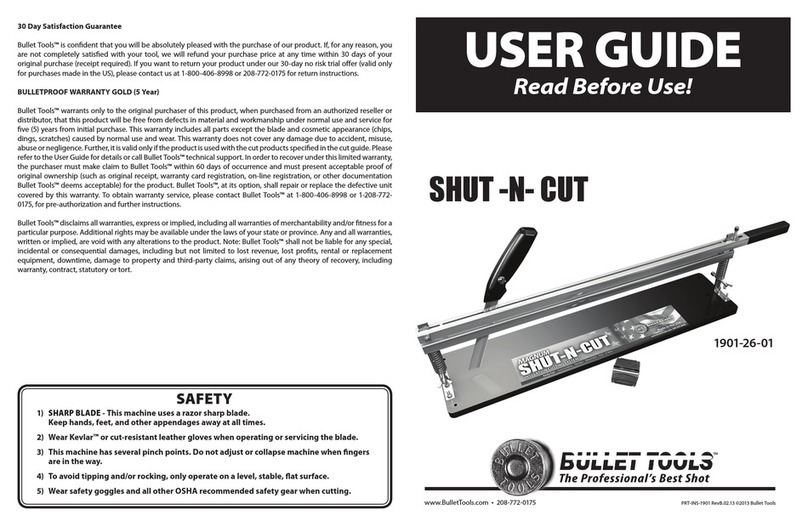
Bullet tools
Bullet tools SHUT-N-CUT user guide

Parkside
Parkside PAAS 12 A2 Translation of the original instructions
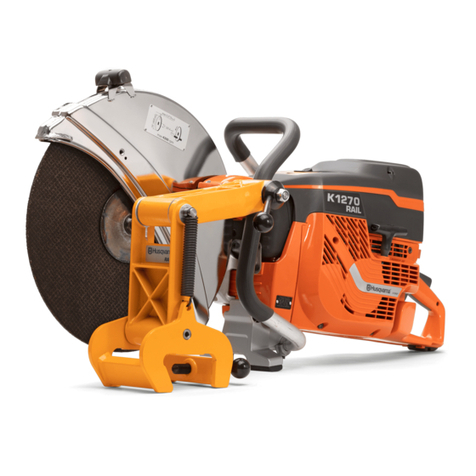
Husqvarna
Husqvarna K1270 II R Operator's manual

Chicago Pneumatic
Chicago Pneumatic CP861 instruction manual
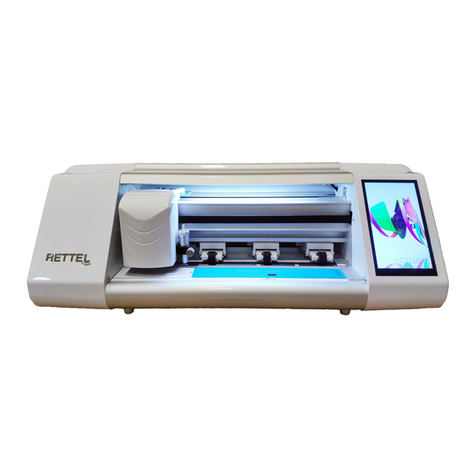
Roland
Roland CAMM-1 Pro PNC- 1410 Service notes
